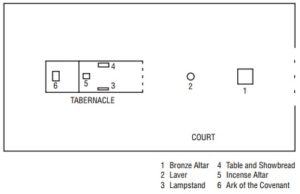Setting
In this lesson we will continue the theme of Jesus’ more excellent ministry. The author has introduced the subject of the tabernacle in the previous chapter and taught that our great High Priest is the Minister of the true tabernacle. Now he goes into greater detail to show how the priestly ministry on earth is a type of the superior ministry of Christ.
Key Verse
(9:12)
Did You Know...?
1. Lampstand (9:2): “Lampstands as receptacles for light-giving vessels were part of the sacred furniture in the central Israelite shrines or sanctuaries described in the Bible. The light given off by the lamps served to illuminate the interior of the sanctuary, and it also functioned as part of a set of ritual objects or acts, appealing to all the senses, that were part of the established priestly ritual…”
[ref]
2. The table and the showbread (9:2): “Made of acacia wood overlaid with gold, it stood on the north side of the Holy Place (Ex 40:22). On it were twelve loaves, arranged in two rows of six (Lev 24:5-6).”
[ref]
“Since the sanctuary is next to the holy of holies, the bread is separated only by a curtain from Yahweh’s immediate presence. In this important location, the loaves symbolize the covenant between God and his people Israel (Lev 24:5–9).”
[ref]
3. Golden censer (9:4): A container for holding burning coals and fragrant incense, which the high priest offered before the Lord in the Most Holy Place (Lev 16:12).
4. Ark of the covenant (9:4): “A chest made of acacia wood, overlaid inside and out with gold (Ex 25:10 16).”
[ref]
5. Cherubim of glory (9:5): “Two winged figures made of pure gold, of one piece with the atonement cover, or mercy seat, and standing at either end of it.”
[ref]
6. Mercy seat/Atonement cover (9:5): “Fitting exactly over the top of the ark of the covenant, it was a slab of pure gold on which the blood of the sin offering was sprinkled by the high priest on the Day of Atonement (Lev 16:14-15).”
[ref]

Diagram A Plan of the Tabernacle
Outline
General Analysis
-
1. In which paragraph does the passage begin to introduce Christ?
Segment Analysis
-
9:1-5
1. Refer to diagram A for the plan of the tabernacle. How does verse 1 introduce the verses that follow?
-
2a. What does the sanctuary represent? (Ex 25:8)
-
2b. Why was the sanctuary and the divine service an integral part of God’s covenant (1)?
-
3. How many parts (rooms) were in the tabernacle?
-
4a. What separated these two parts?
-
4b. What does this symbolize? What happened to it when Jesus died on the cross (Mt 27:50-51)?
-
5a. What articles were in the outer part?
-
5b. What articles did the inner part have?
-
5c. What were in the ark of the covenant?
-
6. What divine attributes are manifest in the Holiest of All (5)?
-
9:6-10
7. Compare the ministry of the priests and the high priest.
-
8. What is the purpose of entering the Most Holy Place?
-
9. What was lacking in the service of the earthly tabernacle?
-
9:11-12
10. How is Christ superior to the earthly high priest in terms of a. The place of service (11) b. The sacrifice (12) c. How often the sacrifice is offered (12) d. The effect of the sacrifice
-
11. What is “eternal redemption”?